In his 1995 article, ‘The Continuing Metamorphosis of the Humanitarian Practitioner: Some New Colours for an Endangered Chameleon’, Dr Hugo Slim—then an academic at Oxford Brookes University—set out an “agenda for good practice for today’s humanitarian practitioner”.
At the time, the ‘new’ operating environment for humanitarian NGOs was that of complex emergencies, characterised by their highly political nature and internal conflict that destroyed governmental and social structures. In response, Slim suggested a range of skills that humanitarian practitioners should have to best meet the challenges of that time and context.
Twenty-five years since the article was published, Melanie Book from CHL interviews Slim about his 1995 article, exploring what’s changed for humanitarian practitioners, what’s stayed the same, and what new skills they need to meet future challenges.
The complex emergencies that Slim identified as a new feature of humanitarian action in the ’90s continue now. From the conflicts and their humanitarian consequences in Somalia, Rwanda and the Balkans that dominated headlines in the ’90s, we now see the situations in Syria, Yemen, Democratic Republic of the Congo and South Sudan, as well as Rohingya in Myanmar and Bangladesh, unfolding with great complexity.
Slim is a Senior Research Fellow at the Institute of Ethics, Law and Armed Conflict (ELAC) at the Blavatnik School of Government. He has held a number of academic and research positions in humanitarian ethics and the protection of civilians at Oxford Brookes University and Oxford University.
His most recent book, Humanitarian Ethics: A Guide to the Morality of Aid in War and Disasters was published in 2015, and from that year until early 2020 he was Head of Policy and Humanitarian Diplomacy at the International Committee of the Red Cross (ICRC).
You can also view this paper as a news article on our website.
Academic contributors
Downloads
-
Skills for the future humanitarian: A conversation with Dr Hugo Slim


